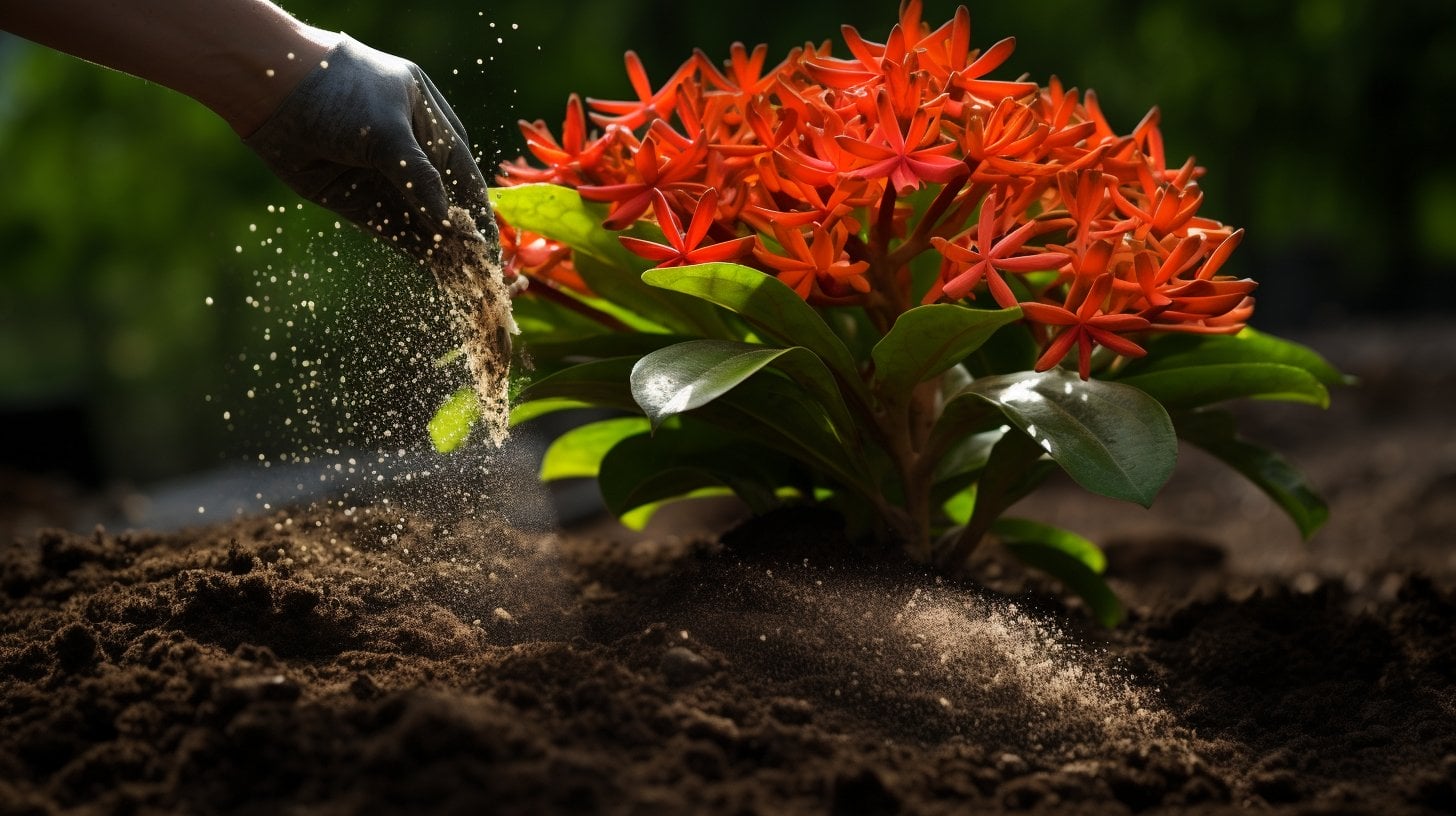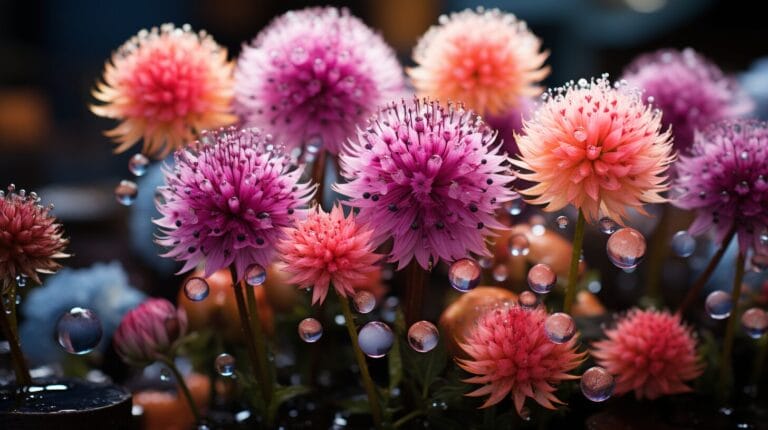What is the Best Fertilizer for Ixora: Guide to Fertilize Ixora Plant
I’ve spent countless years perfecting the art of nurturing Ixora plants. It’s not just about simple tasks like watering and exposing them to sunlight; the choice of the most appropriate fertilizer for Ixora plays a critical role.
I’ve experimented with various brands and formulations, and I’ve finally found the secret to lush, vibrant Ixoras. I’m excited to share this knowledge with you so you, too, can enjoy the beauty of thriving Ixoras in your own garden.
Let’s delve into the world of ixora fertilization together.
Key Takeaways
- Nitrogen, phosphorus, potassium, and micronutrients like iron, manganese, and magnesium are all important nutrients for Ixora plants.
- Maintaining a balanced N-P-K ratio is crucial for optimal growth.
- Micronutrient-rich fertilizers are necessary to prevent nutrient deficiencies in Ixora plants.
- The choice between organic and chemical fertilizers depends on specific needs and environmental factors.
Understanding What Your Ixora Plant Needs: The Key Nutrients
Let’s start by understanding what our Ixora really needs: key nutrients.
We’ll focus on Nitrogen, Phosphorus, and Potassium, all of which are essential for the plant’s growth.
We’ll also touch on the importance of micronutrients like Iron, Manganese, and Magnesium and the crucial role pH balance plays in nutrient absorption.
Highlight essential nutrients: Nitrogen, Phosphorus, and Potassium
I’m going to highlight the essential nutrients for your Ixora, which are Nitrogen, Phosphorus, and Potassium. These are often referred to as N-P-K and are key to understanding what your Ixora needs.
Nitrogen promotes healthy leaf growth by stimulating the production of chlorophyll, the substance that gives plants their green color.
Phosphorus is crucial for the development of roots, flowers, seeds, and fruit.
Potassium, also a vital nutrient, enhances overall plant health by improving disease resistance and water use.
When it comes to choosing the best fertilizer for Ixora, you want to select one that has a balanced N-P-K ratio. This way, your Ixora gets all the essential nutriments it requires to thrive.
Discuss the role of Micronutrients: Iron, Manganese, and Magnesium
Diving into the world of micronutrients, we’ll find that iron, manganese, and magnesium play significant roles in the health and development of your Ixora. Iron aids in chlorophyll production, which is vital for photosynthesis.
Manganese works hand in hand with iron, facilitating the utilization of nitrogen and boosting the plant’s immunity.
Magnesium, on the other hand, is essential for the creation of chlorophyll and the absorption of sunlight.
When you fertilize Ixora, ensure the kind of fertilizer you choose is rich in these micronutrients. Mastering Ixora care involves understanding the role of micronutrients and choosing the right fertilizers for Ixoras.
A deficiency in any of these can limit your plant’s growth, so it’s crucial to provide adequate amounts.
Explain the importance of pH balance for nutrient absorption
In addition to the micronutrients, I’ve found that maintaining the right pH balance in your soil is crucial for nutrient absorption, and without it, your Ixora plant may struggle to thrive. The soil pH plays a significant role in determining the availability of nutriment in the soil. An acidic soil, which these plants prefer, increases the availability of essential nutrients.
Understanding the importance of pH balance for nutriment absorption is fundamental for plant growth. Here are a few key points to remember:
- Acidic soil aids in the absorption of nitrogen, potassium, and phosphorus.
- Soil pH can affect microbial activity, which plays a role in absorption.
- A pH balance that’s too high or too low can lead to nutrient deficiencies or toxicities.
Choosing What is the Best Fertilizer for Ixora Plants
Now, let’s pick the best fertilizer for your Ixoras.
We’re going to look at the pros and cons of organic versus chemical fertilizers, discuss why slow-release granular fertilizers might be a good option, and touch on the importance of micronutrient-rich fertilizers for these beautiful plants.
It’s all about understanding what’ll nourish your Ixora and help it thrive.
Analyze different types of fertilizers: Organic vs Chemical.
I’m about to delve into the comparison of organic versus chemical fertilizers for the nurturing of Ixoras, with a focus on their respective benefits and drawbacks.
When we analyze different types of fertilizers, we see that organic fertilizer is packed with a wide array of nutrients. They enrich the soil and promote a healthier, more sustainable environment for your Ixora. On the other hand, chemical fertilizer provides a quick, high-impact nutriment boost.
Ixora prefers slightly acidic soil, and both types of fertilizers can provide this, but there are some differences to consider:
- Organic fertilizer tends to create a slow, steady release of nutrients, enriching the soil over time.
- Chemical fertilizers provide an immediate nutriment boost but may potentially damage the plant if overused.
- The best fertilizer may depend on your specific needs and environmental factors. It’s all about balance and understanding the unique needs of your plant.
Discuss the benefits and concerns related to slow-release granular fertilizers
While there are several benefits to using slow-release granular fertilizers on your Ixora, there are also a few concerns we need to address.
Slow-release landscape fertilizer, often considered the best fertilizer for Ixora, consistently provides nourishment, promoting healthier, more vibrant blooms. This kind of fertilizer, also suitable for gardenias or azaleas, ensures your plants get a steady, balanced diet of essential nutrients.
However, it’s worth noting that slow-release granular fertilizers can be more costly upfront. Also, they can potentially cause nutriment buildup if improperly applied. To fertilize Ixora plants effectively, it’s crucial to apply the right quantity at the right intervals.
Understanding the benefits and concerns related to slow-release granular fertilizers is key to making an informed decision for your Ixora’s health and growth.
Highlight the need for Micronutrient-rich fertilizers for Ixora
Diving into the topic of micronutrient-rich fertilizers, it’s critical to understand that Ixora thrives when they’re nourished with a balanced diet that includes these essential minor elements. This article section aims to highlight the need for this kind of fertilizer for Ixora.
- Micronutrients support the overall health and vitality of Ixora, enabling them to resist pests and diseases.
- They aid in the photosynthesis process, boosting the plant’s energy production.
- A deficiency in these micronutrients can lead to chlorosis, a condition that causes yellowing of plant leaves.
Unlocking the Best Time to Fertilize Ixora Plant

Now, let’s tackle the timing aspect of fertilizing your Ixora.
Seasonal changes can greatly affect how often and when you should fertilize.
We’ll look at a helpful monthly schedule and discuss why there might be times when your Ixora needs a little extra care.
Explore seasonal considerations for fertilizing ixora plants
I’ve found that a vital part of maintaining healthy ixora involves understanding the best time to fertilize, which often hinges on certain seasonal considerations.
Here are a few factors to consider when you explore seasonal considerations for fertilizing:
- Spring and summer: This is the best time for Ixora to be fertilized. During these seasons, the plant is in its active growing phase, so fertilizing helps it bloom beautifully.
- Fall and winter: It’s advisable to reduce the frequency of fertilization. The plant’s growth slows down and it requires less nutrients.
- Pay attention to the plant’s health: If the plant appears less vibrant in any season, it might need extra nutrients.
Provide a monthly fertilization schedule for optimal blooms
Surprisingly, I’ve discovered that by providing your Ixora with regular monthly fertilization, you can significantly enhance its blooming potential, and this is especially true during its key growing seasons. This monthly fertilization schedule is essential for optimal blooms.
In my experience, the best fertilizer for it is a balanced one, with an equal ratio of nitrogen, phosphorus, and potassium. But, don’t forget about the use of foliar fertilizer. It’s beneficial for Ixora blooming as it delivers nutrients directly to the leaves.
Here’s a table to illustrate my point:
| Month | Fertilizer to Use |
| March | Balanced Fertilizer |
| April | Foliar Fertilizer |
| May | Balanced Fertilizer |
Discuss why Ixora needs more frequent fertilization in certain situations
During specific situations, I’ve noticed that my ixora needs more frequent fertilization to maintain its vibrant blooms and lush foliage. This is likely due to Ixora’s high nutrient requirements and its inability to extract enough nutrients from the soil in certain conditions.
Here are some situations where ixoras need more frequent fertilization:
- When the soil is poor: Ixoras struggle to extract nutrients from poor-quality soil, making the fertilizer for Ixora even more critical.
- During rapid growth: The quick growth of Ixoras in the spring and summer months requires extra nutrients.
- In pots or containers: Ixoras planted in pots or containers exhaust their nutrient supplies swiftly, necessitating more frequent fertilization.
Understanding these situations can optimize the fertilization of your ixoras, ensuring they always look their best.
Preparing Your Soil for Maximum Ixora Growth
Now, let’s talk about how to prepare your soil for optimum Ixora growth.
We’ll start by discussing how to balance the soil’s pH specifically for Ixora.
Then, I’ll share some tips to enhance soil fertility using compost and other organic matter.
And finally, we’ll wrap up with watering techniques to use after fertilizing.
Discuss how to balance the soil pH for Ixora
Honestly, I can’t stress enough how important it is to balance the soil pH when preparing it for maximum Ixora growth. Ixoras thrive in slightly acidic soil, so the goal should be to maintain an acidic soil pH between 5.0 and 5.5.
- Test the soil pH regularly. This is the only way to know if the plants require acidic soil or if adjustments need to be made.
- Use soil additives like peat moss or sulfur to lower the pH if it’s too high. These additives can create the acidic environment that ixoras crave.
- Re-test and amend the soil as needed. Balancing the soil pH isn’t a one-time task, but rather a continuous process to ensure optimal growth for your ixoras.
Offer tips to improve soil fertility with compost and other organic matter
I’ve found that enriching the soil with compost and other organic matter greatly enhances its fertility, setting the stage for robust Ixora growth.
Begin by adding a layer of compost and manure to the top of your soil. Over time, these materials will break down and improve soil fertility, providing a continuous supply of nutrients for your Ixora.
Organic matter also aids in moisture retention, which is crucial for healthy Ixora growth. Additionally, it introduces beneficial microorganisms that contribute to the overall health of the soil.
Educate on watering techniques post-fertilization
After you’ve enriched your soil and applied fertilizer, it’s important to understand that proper watering techniques, in conjunction with the right nutrition, can significantly influence your Ixora’s growth and health. Though you might be tempted to water frequently post-fertilization, I’d advise against it. Here’s why:
- Overwatering can wash away the water-soluble fertilizer, negating the benefits of its use. Aim for deep, infrequent watering to encourage stronger root growth.
- While your Ixora needs plenty of water in the late summer, it’s best to water early in the day to minimize evaporation and maximize absorption.
- Educate yourself on watering techniques post-fertilization. It’s not just about how much you water, but also when and how you apply it to maximize the benefits of the fertilizer.
Can I Use the Same Fertilizer for Large Leaf Indoor Plants and Ixora Plants?
When it comes to caring for your plants, selecting the right fertilizer is crucial. However, using the same fertilizer for both best large leaf indoor houseplants and ixora plants may not be ideal. Each plant has unique nutritional requirements, and it’s recommended to choose fertilizers specifically formulated for their needs.
Beyond Fertilizer: Holistic Ixora Plant Care
While fertilizer plays a crucial role in the growth of Ixora, there’s more to keeping your plant healthy.
Let’s now look into pruning techniques, pest control, and the role of sunlight in ensuring your Ixora thrives.
Advise on convenient pruning techniques for healthier Ixora growth
Beyond the use of fertilizer, I’m going to share some handy pruning techniques that can lead to healthier Ixora growth. The dwarf Ixora, like its larger counterpart, benefits greatly from consistent trimming. Here’s my advice on convenient techniques for healthier ixora growth:
- Always prune after the blooming season. It encourages a healthier plant by letting it focus its energy on root and foliage growth.
- Remove any dead or diseased branches at the base of the plant. It allows for better air circulation and light penetration.
- Lastly, maintain the plant’s natural shape. Over-pruning can stress the plant and inhibit growth.
Discuss pest control to ensure a healthy Ixora plant
In addition to fertilizing and pruning, I’ll now delve into the realm of pest control, because a healthy Ixora also requires protection against harmful insects and diseases.
As a shrubby plant, Ixora is often targeted by pests like aphids, scales, and red spider mites. Regularly inspecting your plant and implementing preventive measures is crucial. I suggest using organic pesticides to keep these pests at bay, ensuring a healthy Ixora.
Remember, pest control isn’t just about reacting to infestations, it’s about prevention too. Along with the fertilizer for Ixora, consider pest control as an integral part of your plant care routine.
This will lead to a vibrant, thriving Ixora that’s a pleasure to behold.
Demonstrate the importance of sunlight for abundant Ixora blooming
I’m now going to highlight the crucial role of sunlight in promoting abundant blooming in your Ixora plant. While the fertilizer for Ixora certainly plays a part in its growth, it’s important to remember that this plant thrives in sunlight. Ixora needs at least six hours of direct sunlight daily to bloom profusely.
To demonstrate the importance of sunlight, consider these points:
- Ixora thrives in sunlight, and it’s essential for photosynthesis, which feeds the plant.
- Abundant Ixora blooming is directly linked to sufficient sunlight exposure.
- Insufficient sunlight can lead to fewer blooms and a weaker plant overall.
Having learned about the optimal nourishment for your vibrant Ixoras, let’s not let your lawn feel left out—discover the secrets to a lush, green canvas with the best nitrogen fertilizer for lawns!
Conclusion
So, you’ve got it! Choosing the right fertilizer for your Ixora plants is a breeze once you know what they need. Remember, a balanced, slow-release blend with essential nutrients is key. Timing and soil prep are crucial, too.
But don’t forget that caring for your Ixora goes beyond just fertilizing. It’s about holistic care that includes good watering, proper sunlight, and regular pruning.
Now, go ahead and grow the most stunning Ixora plants around!
Frequently Asked Questions
What Are Some Common Pests That Can Affect the Health of an Ixora Plant?
In my experience, common pests that can plague ixora plants include aphids, scale, and spider mites. They can severely impact the plant’s health, causing yellowing leaves and stunted growth if not promptly addressed.
Can Ixora Plants Thrive in Indoor Conditions?
Yes, Ixora plants can flourish indoors with proper care. They need bright, indirect sunlight, a humid environment, and well-draining soil. I’d also recommend regular fertilization with a high-acidic fertilizer for optimal growth.
What Are the Best Pruning Practices for Ixora Plants?
For pruning Ixoras, I’d recommend doing it in late winter or early spring. Cut back the entire plant by a third to promote bushy growth. Always remove dead or diseased branches to maintain plant health.
What Is the Expected Growth Rate of an Ixora Plant When Properly Fertilized?
When properly fertilized, I’ve observed that an Ixora plant grows approximately one foot per year. However, it’s important to note that growth can vary based on the specific care and environment provided.
How Often Should I Water My Ixora Plant for Optimal Growth?
In my experience, watering your Ixora plant depends on the climate. In dryer climates, I’d suggest watering it every other day. However, in more humid environments, once a week should be sufficient.






